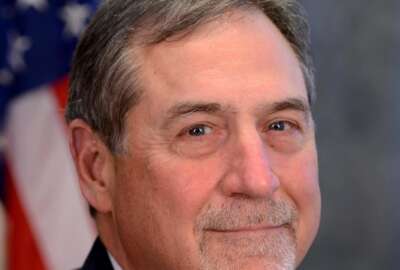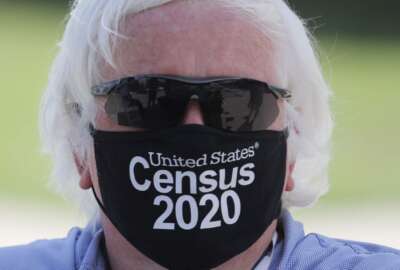
Many unknowns with the 2020 Census
The Census Bureau's big show has been beset with politics, the vicissitudes of technological innovation, and now the pandemic.
Best listening experience is on Chrome, Firefox or Safari. Subscribe to Federal Drive’s daily audio interviews on Apple Podcasts or PodcastOne.
The Census Bureau’s big show has been beset with politics, the vicissitudes of technological innovation, and now the pandemic. It has only weeks to wind up the data gathering for the 2020 count. Will it come out — right? Will everyone trust the results? For the big questions with some perspective and a call for action, the former Census Bureau Director John Thompson joined Federal Drive with Tom Temin.
Interview transcript:
Tom Temin: Mr. Thompson, good to have you on.
John Thompson: Thank you. Good to be on.
Tom Temin: You dealt with some of these questions in your long tenure with Census and you did get deeply involved with several of the decennial counts. This one seems a little bit more beset than usual, doesn’t it?
John Thompson: I think this is the greatest challenge the Census Bureau has faced since I’ve been involved in census-taking.
Tom Temin: What is the source of it? Is it the pandemic solely or is it some of the discussions that the national debate on immigration and so forth have impinged on the census repeatedly over the last couple of years?
John Thompson: Well, I think it’s a number of factors that you mentioned. So first off, the COVID-19 pandemic has had a big effect on the census. They’ve had to delay some of their critical operations for quite a while. So for example, the operation that they used to collect the information from those households that don’t self respond, they call that their nonresponse follow up. Those initially scheduled to run from May 15 through the end of July, and the Census Bureau was forced to reschedule it to begin in early August and run through the end of October. So consistent with that the professionals at the Census Bureau looked at their schedule, and they said, well, we need to extend our legal deadlines if we’re going to deliver our best quality product. And that meant basically a four-month delay. Well, now they have been told that they can’t have that four-month delay. And so they’ve had to change their operations. They’re going to end their nonresponse follow up a month early, and they’re going to be very rushed.
Tom Temin: Yes, they’ve said, I think the director Mr. Dillingham said they would add staff between now and then to try to boost up response. But I guess from a standard industrial operational theory standpoint, it’s never a good idea to have to rush and change things when you are at the peak of operating towards a goal, is it?
John Thompson: No, in fact, I think it’s going to be very hard to add substantially more staff than they were currently planning to add. I mean, they’ve only got about eight weeks. So there’s just not much time.
Tom Temin: Because you said, one of the reasons is they wanted to leave time for the data processing of the incoming data. And I would think that in recent years, given all of the increase in computing power that just about everybody has the data processing would be the simplest part of the whole thing, yes?
John Thompson: They have to do some fairly complicated process and I won’t get into the details, but that’s part of the reason they wanted to extend their deadlines for four months because they were initially going to end at the end of October, and then they wanted to extend to the end of April. to actually deliver the count. So there’s a lot of work that has to be done. And they’re going to have to be taking some modifications to those programs. And that’s always kind of a danger when you have to modify a big set of computer programs right at the last minute.
Tom Temin: So it’s really up to Congress. And they have not answered that call to delay because I think only – I don’t think the administration legally can do that. That’s something that’s on Capitol Hill’s shoulders.
John Thompson: Right, that’s exactly right, Tom. There’s a statute with legally mandated deadlines. And unless that statute is changed, then the Census Bureau has to deliver as they were previously scheduled to.
Tom Temin: So basically, then the question becomes, is legitimacy going to be accepted by everyone? Because I guess a four-month extension is not a great idea, but nobody anticipated the pandemic. It would be better, in your opinion to have a accurate and supportable and supported result at the expense of a deadline which in the grand scheme of things is only four months over every 10 years.
John Thompson: Right. In fact, three of my former Census Bureau director colleagues and I wrote a piece where we actually endorsed the idea of extending the deadlines. And it was a bipartisan group of previous directors.
Tom Temin: We’re speaking with former Census Bureau Director John Thompson. And I want to get into that because you’ve also advocated some kind of an oversight commission, a nonpartisan group that would look at the whole thing to try to engender some transparency, accountability. What is that specific proposal?
John Thompson: So right now there is a risk that the census will have to rush and that there might be some serious undercounts introduced into the census. And then the question is, will it be good enough for use and apportionment or redistricting? And so what we recommended was that some independent organization that could be like the National Academy of Sciences, the American Statistical Association – some organization that the Congress would feel comfortable with – would develop some metrics and measures in advance of seeing the data or in advance of the data being released. And then those measures could be used to assess the fitness for use of the census, and make people either feel comfortable that results were acceptable or give Congress a warning that they’re sub par.
Tom Temin: Because I remember it was either the 2010 count or maybe the 2000 count, the question comes up, and it’s usually pretty quickly rejected – the idea of statistical sampling and projection of results versus counting every nose. And the Constitution doesn’t allow for that, except for anything but counting the noses. So is that what you mean? We have to do a little bit of statistical sampling this time?
John Thompson: Well, I think we – no, well, not not for the census itself. You might have to do some statistical sampling to evaluate the quality of it. That’s a technique that’s been used for many census but that a sampling rate – to correct the census. What we were saying was look, let’s get some measures in advance that the census has to meet so that the quality of it could be assessed and its fitness for use can be determined.
Tom Temin: And there’s a fundamental issue I wanted to ask you about also, and that is something you mentioned briefly earlier, and that is the professionals at the Census Bureau. It’s kind of a calling and a specialized profession doing what the Census Bureau people do as careers, and the political people at the top of the Bureau and at the top of the Commerce Department come and go. I’m imagining that the career staff is really what’s holding this whole thing together at this point. Is that your assessment?
John Thompson: Yeah, you couldn’t do the census without the career staff. I think right now, there might be six political appointees at the Census Bureau. That certainly – they can’t take a census. In fact, when I was there as a director, I was really thankful for the great career staff we had that could carry out such an endeavor.
Tom Temin: Yeah, I didn’t mean that the six people would do it instead of the career staff, or that the career staff has the bigger view here in terms of what really has to get done despite what might be thought of by the above.
John Thompson: It’s a big management operational challenge. And so you need some people that are really steeped in operations and management to carry out such a large endeavor.
Tom Temin: And what’s the thinking, again, the, I guess, best practices thinking or the traditional thinking about counting illegal aliens, people that don’t have documentation that are in the country, because it does result in congressional apportionment and the allocation of federal aid to those locales? And without getting into the politics of it, what has been the approach to that in the past?
John Thompson: So I worked on the 1980, 1990 and 2000 census, and I was preparing for the 2020 census. In each of those censuses, we follow the practices that have been following previous censuses. And our mission was to count everyone in the United States where they usually live, regardless of immigration status. In fact, we didn’t ask for immigration status, and they still don’t ask for immigration status now. And again, I’m not a constitutional lawyer, so I followed the practices that were explained to me by people that were constitutional lawyers, that the Constitution required that we count everyone and I had no reason to question it.
Tom Temin: In that proposal that you have sent to – well who did you send it to, the idea of having that commission overlook this whole thing?
John Thompson: Well, we put out a letter for wide circulation. The intended audience was the Congress of the United States.
Tom Temin: Any response from anyone yet?
John Thompson: No, not yet.
Tom Temin: John Thompson is former director of the Census Bureau. Thanks so much for joining me.
John Thompson: Sure, thank you.
Tom Temin: We’ll post this interview at FederalNewsNetwork.com/FederalDrive. Hear the Federal Drive on demand. Subscribe at Apple Podcasts or Podcastone.
Copyright © 2025 Federal News Network. All rights reserved. This website is not intended for users located within the European Economic Area.
Tom Temin is host of the Federal Drive and has been providing insight on federal technology and management issues for more than 30 years.
Follow @tteminWFED




